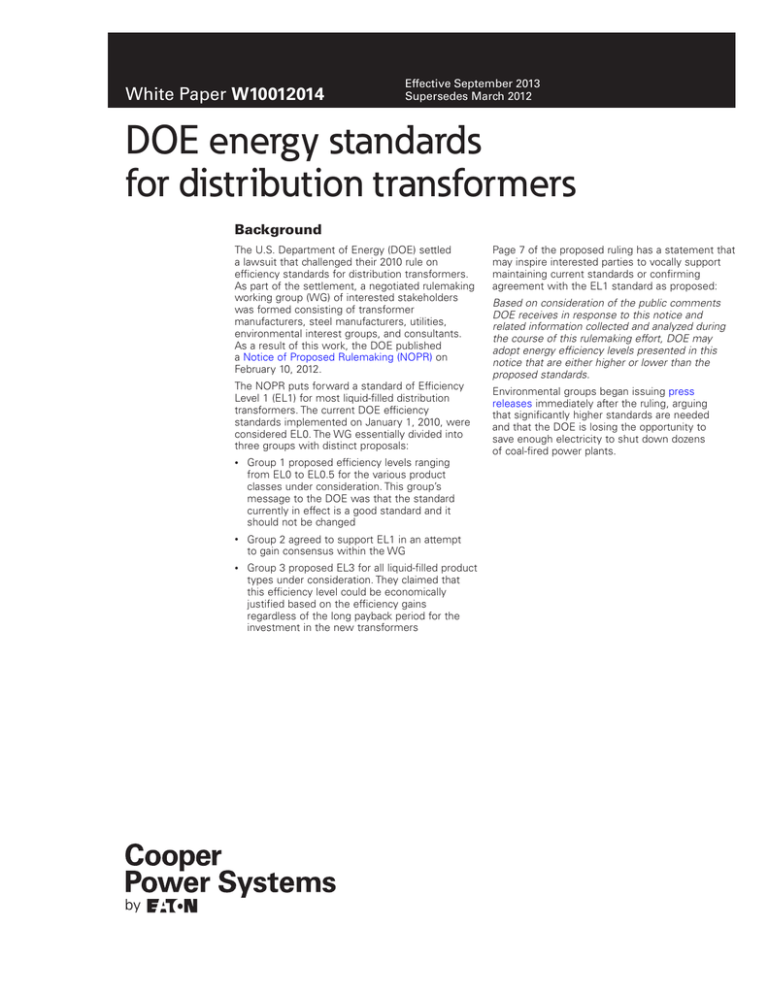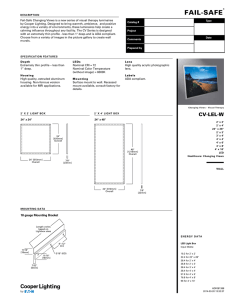
White Paper W10012014
Effective September 2013
Supersedes March 2012
DOE energy standards
for distribution transformers
Background
The U.S. Department of Energy (DOE) settled
a lawsuit that challenged their 2010 rule on
efficiency standards for distribution transformers.
As part of the settlement, a negotiated rulemaking
working group (WG) of interested stakeholders
was formed consisting of transformer
manufacturers, steel manufacturers, utilities,
environmental interest groups, and consultants.
As a result of this work, the DOE published
a Notice of Proposed Rulemaking (NOPR) on
February 10, 2012.
Page 7 of the proposed ruling has a statement that
may inspire interested parties to vocally support
maintaining current standards or confirming
agreement with the EL1 standard as proposed:
The NOPR puts forward a standard of Efficiency
Level 1 (EL1) for most liquid-filled distribution
transformers. The current DOE efficiency
standards implemented on January 1, 2010, were
considered EL0. The WG essentially divided into
three groups with distinct proposals:
Environmental groups began issuing press
releases immediately after the ruling, arguing
that significantly higher standards are needed
and that the DOE is losing the opportunity to
save enough electricity to shut down dozens
of coal-fired power plants.
•
Group 1 proposed efficiency levels ranging
from EL0 to EL0.5 for the various product
classes under consideration. This group’s
message to the DOE was that the standard
currently in effect is a good standard and it
should not be changed
•
Group 2 agreed to support EL1 in an attempt
to gain consensus within the WG
•
Group 3 proposed EL3 for all liquid-filled product
types under consideration. They claimed that
this efficiency level could be economically
justified based on the efficiency gains
regardless of the long payback period for the
investment in the new transformers
Based on consideration of the public comments
DOE receives in response to this notice and
related information collected and analyzed during
the course of this rulemaking effort, DOE may
adopt energy efficiency levels presented in this
notice that are either higher or lower than the
proposed standards.
White Paper W10012014
DOE energy standards
for distribution transformers
Effective September 2013
Key issues
Conclusion
At EL2 and EL3, most transformer design configurations are not
achievable with conventional core steels and will require amorphous
core steel for most applications. Amorphous metal transformers
are larger and heavier than conventional units of the same kVA
rating. The handling of the transformers by the utility will likely be
impacted, including the potential need to reinforce or replace utility
poles due to the added weight.
Eaton’s Cooper Power Systems supports the proposed EL1
efficiency standard rather than any of the higher efficiency levels.
The EL1 levels will allow manufacturers to compete on a price/
performance basis, using both conventional and amorphous core
transformers. Raising transformer efficiency requirements beyond
the proposed EL1 levels is not economically justifiable, and will
negatively impact utilities and unnecessarily burden consumers
with higher utility rates as a result.
Amorphous core transformers are able to save energy and have
lower losses during periods of low loading, mainly at night; however,
during peak loading conditions, or any time loading levels exceed
50%, conventional core transformers are more efficient. These
high loading conditions coincide with the periods when the cost of
energy is highest.
According to the DOE’s calculations, adopting EL1 would result in
an average price increase of 21% over the base price of a 2010 DOEcompliant transformer across the various liquid-filled transformer
designs considered. Higher efficiency levels would be even more
expensive due to:
•
Increased weight
•
Increased amorphous demand, which will likely result in higher
prices for the metal because the North American market is served
by only one manufacturer headquartered in Japan
•
Increased capital equipment costs as amorphous metal
requires different core making and assembly equipment for
the transformer manufacturers
Eaton
1000 Eaton Boulevard
Cleveland, OH 44122
United States
Eaton.com
Eaton’s Cooper Power Systems
2300 Badger Drive
Waukesha, WI 53188
Eaton.com
© 2013 Eaton
All Rights Reserved
Printed in USA
Publication No. W10012014 / Z14256
September 2013
Eaton is a registered trademark.
All other trademarks are property
of their respective owners.


